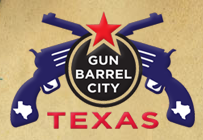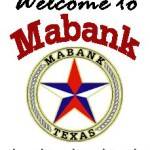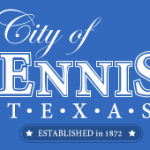Scurry Texas
Scurry is a town in Kaufman County, Texas, United States. It was incorporated in 2003. A July 1, 2008 U.S. Census Bureau estimate placed the population at 719.
The first settlers in the area arrived in the mid-1840s. Over the next quarter century, a church and school community developed and the number of farms increased. The arrival of the Texas and Pacific Railway in the 1870s established the settlement as a shipment point for area farmers. When local residents requested a post office, they submitted the name Scurry – in honor of Scurry Dean, who was killed during the Civil War. Post service began in 1883 and a year later, Scurry had an estimated population of fifty. By 1914, the community was home to around 400 people as well as a number of businesses. The Great Depression caused Scurry to decline, which lasted through the first decade after World War II. Only 250 people remained in the community by the mid-1950s. The trend was later reversed during the latter half of the twentieth century. In 1990, there were nine businesses and approximately 315 people living in the community. That figure approached 600 by 2000 and Scurry was officially incorporated as a town three years later.
Scurry Texas is approximately 21.7 miles from Lonestar RV Parks via FM-148S and TX-274S
Gun Barrel Texas
 Gun Barrel City is a city in Henderson County, Texas, United States. The population was 5,672 at the 2010 Census.
Gun Barrel City is a city in Henderson County, Texas, United States. The population was 5,672 at the 2010 Census.
The town began as an unincorporated community known as the “Old Bethel Community” in the 1960s after completion of Cedar Creek Reservoir. It was incorporated in the late 1960s so it could legally sell beer and wine. The city takes its name from a former road, Gun Barrel Lane (which is now State Highway 198), as well as its motto, “We Shoot Straight with You” and its symbol – a rifle with two crossed antique pistols. Gun Barrel Lane got its name during the 1920s and ’30s when outlaws frequented the area. It was considered a safe backwoods place during Prohibition when the likes of Clyde Barrow and Bonnie Parker hung out in the area. A local resident, Mr. C. L. Wait, lived along the road and was known for sitting at the window of his house with a shotgun sticking out the window. It was his way of deterring those he deemed unwelcome on this back country road.
Despite having a name that evokes images of the Texas Frontier, Gun Barrel City is only fifty years old. Not long after Cedar Creek Lake (a reservoir for the Tarrant Regional Water District) completed construction, the fledgling community that sat on its banks took steps to officially become a city.
Gun Barrel City was incorporated on May 26, 1969. Since that time, Gun Barrel City has grown into the central hub and access point for the waters of Cedar Creek Lake. This has led visitors from around the region to use Gun Barrel City as the gateway into the lake. In addition to the high amount of tourism that the community witnesses (particularly during the summer boating season), Gun Barrel City and the surrounding communities have experienced a residential building boom over the past several years. This growth has largely been led by the relocation of wealthy retirees from throughout the Dallas region, building large lake homes in order to take advantage of Gun Barrel City’s lake access.
In May 2000, Gun Barrel City voters elected their 13th Mayor, 21-year-old Entrepreneur and Newspaper Publisher, Randal Tye Thomas, who became a media and political celebrity in the Dallas, Texas metropolitan area. After a very successful year as Mayor, marked by widespread community support, he resigned suddenly in May 2001 following a Grand Jury indictment for one count of misdemeanor perjury and in the same week being arrested by the Gun Barrel City Police Department for Public Intoxication. All criminal charges were eventually dismissed. Thomas and the community were featured in many local, state, and national publications and programs, including a feature story in the magazine Texas Monthly and a feature interview on the popular nationwide NPR program This American Life. Thomas moved to the Dallas, Texas area in 2002.
In 2008, Gun Barrel City received the coveted Certified Retirement Community recognition from the Texas Department of Agriculture’s Go Texan program. The community has also received recognition from the Governor’s Office, receiving second place on two separate occasions in the Governor’s Community Achievement Awards.
Lonestar RV Parks is located approximately 4 miles from Gun Barrel Texas via TX-334W
Kemp Texas
 Kemp is a city in Kaufman County, Texas, United States. The population was 1,154 at the 2010 census.
Kemp is a city in Kaufman County, Texas, United States. The population was 1,154 at the 2010 census.
The community was named for Sara Kemp, mother of Levi Noble, the first postmaster, and was officially established when the post office opened in 1851. The original townsite was located on present day County Road 4023 two miles south of present day Texas State Highway 274. It grew slowly during its first thirty years. A Presbyterian congregation was organized in 1854, and the Kemp Academy of Learning began operation in 1867. After the Civil War an increasing number of settlers moved to the community. In 1870 Dr. A. J. Still, hoping to profit from this growth and the possible construction of a railroad through the area, bought land just north of the community (where the current City sits) and, after surveying, dividing the tract into lots, platted it, and persuaded the directors of the Southern Pacific Railroad to lay tracks across his property by offering the company a number of lots. Another early settler, Sam Parmalee, followed suit and offered the rail company right-of-way through his property. The mid-1880s witnessed the completion of the rail line through the community, the construction of a depot there, and the designation of Kemp as a terminus on the line.
The railroad attracted settlers to Kemp. Prospering with the surrounding cattle ranches and cotton farms, the community developed as a trade center for the lower part of the county. By the early twentieth century the population had reached 513, and the Methodist and Baptist congregations had established churches. Kemp also supported a local newspaper, the Kemp News. The paper was owned and edited by Mike S. Boggess. In 1926 the town had a population of 1,200, sixty businesses, and two banks. By 1936 forty-six businesses operated in Kemp. The population declined from 1,000 to 816 between the end of World War IIqv and the mid-1960s. Businesses declined from forty-one to thirty-three. In 1965 Cedar Creek Reservoir was completed just south of the community. Kemp had a population of 1,184 and seventy-five businesses in 1990. Much of the land around town was still devoted to cattle production, and many residents commuted to jobs in the Dallas area. In 2000 the population was 1,133.
During the summer of 2011, the City received national attention due to its aging water utility system and complications resulting from the severe Texas drought of 2011.
Lonestar RV Parks is located 9.4 miles via TX-274N
Athens Texas
Athens is a city in Henderson County, Texas, in the United States. As of the 2010 census, the city population was 12,710. It is the county seat of Henderson County.The city also calls itself the “Black-Eyed Pea Capital of the World.”
Athens was selected as one of the first ‘Certified Retirement Communities’ in Texas. It was named after Athens, Alabama by one of the early residents who came from there.
Lonestar RV Parks is located approximately 24.7 miles from Athens Texas via US-175E and TX-334W
Malakoff Texas
 Malakoff is a city in Henderson County, Texas, United States. The population was 2,257 at the 2000 census. The community is named after a Russian fort of Malakoff (Malakhov kurgan), which played a pivotal role during the siege of Sevastopol during the Crimean war.
Malakoff is a city in Henderson County, Texas, United States. The population was 2,257 at the 2000 census. The community is named after a Russian fort of Malakoff (Malakhov kurgan), which played a pivotal role during the siege of Sevastopol during the Crimean war.
The City of Malakoff is served by the Malakoff Independent School District. The mascot is the Tiger.
The private Saint Paul Industrial Training School, orphanage and school, is located near Malakoff. It was begun in the 1920s by James William and Alice Olenza Wingfield Smothers. It continues to serve African-American youth, many having been previously homeless. It receives no federal funds.
Malakoff is approximately 19.1 miles from Lonestar RV Parks via TX-31 and TX-274N
Mabank Texas
 Mabank is a town in Henderson and Kaufman counties in the U.S. state of Texas. The population was 3,035 at the 2010 census.
Mabank is a town in Henderson and Kaufman counties in the U.S. state of Texas. The population was 3,035 at the 2010 census.
Prior to the existence of Mabank in early 1900, the community of Lawndale was formed in the late 1880s. The community was noted for its agriculture in many areas, including cotton. But with the Texas Trunk Railroad missing the community by a mile, Ranchers Mason and Eubank decided to capitalize on the Texas Trunk and set aside one square mile of land and named it “Mabank”.
Mabank is a combination of the names Eubank and Mason and is located one mile (1.6 km) southwest of the former community of Lawndale. Being only a mile away from Lawndale and located on the railroad, its citizens, churches, and businesses naturally decided to move there. Thus attracting, over a brief period of about two years, much of what was Lawndale. This included the Lawndale Courier – the local newspaper that renamed itself the Mabank Courier.
Many of the descendants from the Masons and Eubanks are still alive to this day.
Populations went up highly in the 1960s and 70’s due to the building of Cedar Creek Reservoir.
Mabank is approximately 8.6 miles from Lonestar RV Parks vis TX-198 and TX-334W
Ennis Texas
 Ennis is a city in Ellis County, Texas, United States, and a southeastern suburb of Dallas. The population was 18,513 at the 2010 census.
Ennis is a city in Ellis County, Texas, United States, and a southeastern suburb of Dallas. The population was 18,513 at the 2010 census.
The annual National Polka Festival which features Czech cuisine, polka music, dancing, and a parade is held on Memorial Day weekend. The festival started in 1967 by a group of men who thought their Czech heritage should be honored. There is also a contest to find who the Duke and Dutchess of Ennis will be for the year. During the 3 day festival, the Ennis Polka Run takes place to help fund the Rotary Club and the Children’s Reading Club of Ennis.
Ennis has an annual Bluebonnet festival during the month of April. During this time, thousands of tourists come to see the bloom of these wildflowers. Ennis is also considered the “Bluebonnet Capital of North Texas”.
Ennis is the only incorporated city in the United States that still elects its City Marshal. The election is held every two years with the winner being named Chief of Police by the City Council and City Manager. Currently the post is held by Chief John Erisman.
Ennis is home to the Texas Motorplex, a quarter-mile drag racing facility built in 1986 by former funny car driver Billy Meyer. It annually hosts the NHRA O’Reilly Fall Nationals each September, when hundreds of professional and amateur drag racers compete for over $2 million in prize money. In March 21, 2009, the TV show Pinks: All Out hosted a contest at the Motorplex.
Ennis is located approximately 26.9 miles from Lonestar RV Park via FM85E
Kaufman Texas
 Kaufman is a city in Kaufman County, Texas, United States. The population was 6,703 at the 2010 census. It is the county seat of Kaufman County.
Kaufman is a city in Kaufman County, Texas, United States. The population was 6,703 at the 2010 census. It is the county seat of Kaufman County.
Kaufman was the first place that Bonnie Parker from Bonnie and Clyde was incarcerated. The city is named after Kaufman County, which was named after David S. Kaufman,
The city of Kaufman and surrounding portions of Kaufman County are served by the Kaufman Independent School District.One of the most popular spots in the Kaufman area is Tanger Outlet Mall, a shopping destination featuring apparel, accessories, entertainment, food, footwear, housewares and much more.
Kaufman is approximately 20.8 mi from Lonestar RV Park via US-175E and TX-274N.
How-To De-Winterize and Prepare for the Upcoming RV Season
If you haven’t already done so, no is the time to get started on preparing your RV for the camping season. Unusually warm weather has caused many to get a head-start on the process. How about you?
Here is a fairly comprehensive list of basic tasks. You will likely have to modify slightly depending upon the type of rig you own:
OUTSIDE
Remove Cover Straps
Remove Cover (guess who forgot to undo the straps last year!)
Inspect Cover for Rips and Tears, Repair if Needed/Possible
Roll and Fold Cover and Store.
Inspect Outside
Inspect Underneath For Leaks, Puddles, Dry Rotted Hoses, Excessive Rust, Gas Pipe Joints,Frame, etc.
Inspect Tires and Inflate to proper pressure (Check Dates!)
Wash RV and Inspect for cracks, chips, glass breaks, leaks, etc.
Repair if needed.
Open Outside Engine Compartment, Check for Leaks and Nests.
Open Storage Compartments and Inspect (leaks, bugs, critters, etc.)
Clean Outside Refrigerator Compartment (Spiderwebs, Leaves, Nests, etc.)
Clean Outside Furnace Compartment (Spiderwebs, Leaves, Nests, etc.)
Clean Outside Water Heater Compartment (Spiderwebs, Leaves, Nests, etc.)
Replace Water Heater Drain Plug and/or Anode.
Clean Battery and Terminals if Needed. (Chassis, House and Generator)
Check Coach and Chassis Battery Water Level, Refill if needed. (Distilled Water ONLY!)
INSIDE
Open Door(s) Test Operation
Turn On Lights, Replace Any Bad Bulbs
Open Vents, Test Seal and Operation
Open Windows, Test Seals and Operation. Check Locking Mechanisms
Open Cabinets (Upper and Lower)
Check for Leaks, Roof, Doors, etc.
Check for Critters. (Bugs, Mammals, Gremlins, etc.)
Clean Interior (Carpets, Walls, Floors, Cabinets, Fridge, etc.)
Check LP/Propane/CO Detector Operation
Check Smoke Detector Battery and Operation
Check Monitor Panel, Tanks and Propane
Check Converter/Charger For 12 Volt Output
Check All Fuses and Breakers (12V and 120V)
Confirm Solar Charging System Voltage and Amperage
Check Bathroom Skylight for leaks and cracks.
Check and Tighten ALL screws and fasteners Everywhere!
MECHANICAL
Check Oil Level, Fill if Needed
Check Coolant Level, Fill if Needed
Check Brake Fluid Level, Fill if Needed
Check Power Steering Fluid Level, Fill if Needed
Check Transmission Fluid Level, Fill if Needed
Check Windshield Fluid Level, Fill if Needed
Check All Hoses and Tighten Clamps
Check Airbag Compressor for operation and leaks.
Check Air Bag System Pressure
Check Air bag System for Leaks
START-UP CHECKLIST
Check Fuel Levels
Check Battery Volts
Start Engine
Check for Oil Pressure Rise
Listen to Idle (Sound OK?)
Check Idle Speed RPM
Check for Battery Charging (Volts/Amps)
Check Temperature Gauge for Rise
Listen for “strange” noises. Clangs, Bonks, Whistles, Squeals, Chattering, Rattles, Clunks etc.
Shift Into Each Gear (Foot on Brake!!)
Switch On Dash Air Conditioner (Got Cold Air?)
Select Dash Heat and Defrost (Got Hot Air?)
Shutdown After Everything Warms Up to Operating Temperature
Re-Check Oil Level, Fill if Needed
Re-Check Transmission Fluid Level, Fill if Needed
GENERATOR CHECKLIST
Check Generator Compartment for Oil Leaks
Check generator and Wiring for Obvious Problems
Check Oil Level, Fill if Needed (Coolant too! If you have it)
Start Generator
Check for leaks
Check for Transfer Switch Operation
Run for 30 minutes (or so)
Check Voltage at Sockets without Load
Check Voltage at Sockets with Load
Shutdown Generator
Turn On Inverter
Check AC Power From Inverter
PROPANE SYSTEM
Turn On Gas at Main Tank Valve
Listen and Check for Leaks (Use handheld detector)
Check for leaks in Refrigerator, Furnace and Water heater Compartments
Check for leaks Inside (Stove, Water Heater, Furnace, Refrigerator)
Light 1 Burner, Check for Blue Flame and Even Burn
Turn Off
Check Other Burners.
Turn Off Stove Valves
Set Thermostat to Heat
Confirm Furnace Ignition
Confirm Heater Vent Airflow and Temperature
Shut Off Thermostat
Confirm No Leaks from Valves in the OFF Position
APPLIANCE CHECKS (On Both Shore Power AND Generator/Inverter)
Attach Shore Power (or use Generator)
Turn on Air Conditioner, Wait for it to engage
Check for Cool Air
Check for Heat Strip Operation (if installed)
Shutdown Air Conditioner
Inspect Microwave
Set Clock
Run for 1 Minute (heat something up!)
Check Coffee Maker Operation (VERY Important!)
Check Fridge DC Control Panel Operation
Turn On Refrigerator (on AC Power)
Confirm Refrigerator Heating Element is Warming Boiler Outside)
Switch Refrigerator to Propane (LP Gas)
Confirm Flame Ignition (By Sound AND Visually Outside)
Switch Back to Electric (or AUTO)
Check Refrigerator Door Seals and Lock(s)
Turn On Entertainment System
Check Inputs (Antenna/VCR/DVD/Satellite/VGA)
Check Sound
Raise/Lower TV/Satellite Antenna
Turn Everything Off.
WATER SYSTEM (without Sanitize)
Re-Connect Water Pump to Tank
Set Valves to Tank Fill
Re-Insert Water Heater Drain Plug
Close Low Point Hot and Cold Water Drains
Check All Fittings
Close Faucets
Partially Fill Water Tank (Hose or Connect City Water)
Set Valves To Operating Position
Pressurize System (Pump and City Water, One at a time)
Check For Leaks
Open Each Faucet Until It Runs (to Remove Antifreeze and Air)
Check Toilet Main Drain. (Holding Antifreeze?)
Check Flush Fill and Drain
Fill Fresh Water Tank (and/or Use City Water)
Check For Leaks (Look in All Cabinets! Under Coach as Well!)
Open Faucets and Run Water until Clear
Check For Leaks AGAIN!!
Turn On Water Heater (Propane)
Check for Ignition
Confirm Hot Water and Flow
Check For Leaks (Inside Hot Side Plumbing AND Outside Water Heater Compartment)
Switch Water Heater to Electric
Confirm Hot Water and Flow
Shut Everything Down
LAST
Close All Windows
Shut Off All Appliances
Shut Down Propane Gas Flow
Turn Off Lights
Close and lock Doors.
After completing the steps, it is hopeful you will find a little more peace of mind knowing you were thorough in your preparation. Good RVing!
How to Install a Transmission Oil Cooler Fan – Pt 2
Finally, a weekend with no rain forecast. Not that it wasn’t the case last week, but these “meteorologists” seem to make guesses rather than actual predictions based on fact. Maybe I’m just bitter since it put a stop to my relaxation activities. Mainly, working on my RV!
So now that I can comfortably(?) lay under the RV and not get soaked, lets finish up the transmission oil cooler supplemental fan install. You know, that’s an awful lot of words to just say “fan.” We left off with all the parts assembled and ready to install.
| My Transmission Oil Cooler in The Front Engine Bay |
First I attached the fan itself to the back of the transmission oil cooler. I thought about making it a “pusher” fan rather than a “puller fan” by mounting it on the front, but I believe I will get better airflow by sucking air up from below the front of the engine compartment rather than air from behind the engine and transmission. Once everything is in place, I’ll put a temperature probe in there and see what’s what.
| Opposite side from the Fan With Sticky Pad and Lock in Place |
| Hold Downs |
The fan get’s mounted using long plastic hold downs with a circular stopper on one side and a spring and cap on the other. It is inserted through the tabs on the fan and through the cooler itself.
| Almost Finished Install – Viewed From Front |
You then slide on the supplied padded squares, with the sticky side toward the radiator, over the rod. These stick to the radiator and offer some padding and vibration resistance. Once done, make sure the fan turns freely and doesn’t hit the cooler. If it does use a spacer or washer to add some gap. Too much gap is no good, as air will escape around the fan instead of cooling your transmission oil. Then comes the circular lock. BE CAREFUL! This will only go on once. It cannot be removed without destroying the rod or the plastic lock, so make sure everything is where you want it before you push them on. Once tight, snip the extra rod leaving a bit protruding.(1/4-1/2″-ish)
| Tight Install Behind Transmission Cooler |
I had very little clearance behind the transmission oil cooler, and the top of the fan hits the surround of the engine radiator’s supplemental fan, but just a very little bit. It also hangs down a smidgen since the fan is actually 10″ across even though the specs show it to be 9″ wide. If I were to do this again (NOT!) I would buy an 8″ fan so the total size would likely be 9″. Ah well, at least when you buy a fan you’ll get the right one!
| Accessory Switch is Second From Right, Bottom Row |
Next was the electrical hookup. This was, by far, one of the easiest I’ve ever done. The negative lead (BLACK) runs over to the Negative terminal of the battery or, even easier, to a convenient screw already in the chassis. (The Chassis/Frame IS a ground.) The other (POSITIVE) wire will go to one side of a switch near your driving position. Sometimes this is REALLY simple, but often can be tough since the wire MUST go through from the outside to the inside. Then the wire gets hooked up to a fused power source. This should be from your Engine’s wiring, NOT the House system. There is usually someplace you can tap into within the existing fuse block. I used the ACCESSORY switch that was already in the dash, fused and unused. You can easily add a switch to your dash (or other convenient location.) If you cannot find power inside, you could run another wire back out, and down to the battery’s positive terminal making sure you have a correctly sized fuse installed on the wire. If you go this route save time by running two wires at the beginning!
| Supplied Electrical Install Kit |
This is the time to decide if you’d like to install a thermostatic switch. It will turn the fan on at a predetermined temperature and back off when it is reached again. I have one, but didn’t install it. I want to do some testing before I let the system work on it’s own.
Once it’s all hooked up, make sure that the fan turns the right way! If it’s behind the cooler it should draw air THROUGH it from front to back. If it’s in front it should push air through the cooler. If it’s wrong, you likely have the wires reversed. On many fans this is the way to reverse the direction anyway so it’s not too big a deal if you get it wrong. Just switch the wires at the fan and you’re good to go.
WARNING! Some fan manufacturers want you to actually remove the fan blades and turn them over to switch the direction of the airflow. Switching the wires MAY damage this type of fan!
| Finished Install |
You should use heat shrink tubing or some other method to waterproof the connections that will be outside and usually underneath the RV. They will be subjected to some nasty elements like road salt, water…etc. It’s a good idea to protect them. Yes, I know…put the heat shrink tubing on BEFORE you put all the wires together. See even I can learn after several mistakes!
I believe I will see some significant reduction in temperatures. Stay tuned, after the season I’ll tally the results and write it all up.
Be Seeing You…Down The Road,
Rich “The Wanderman”
www.thewanderman.com
